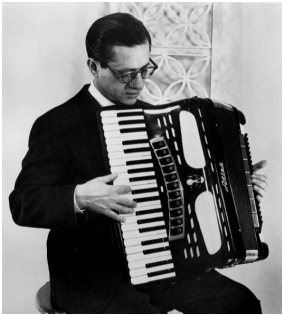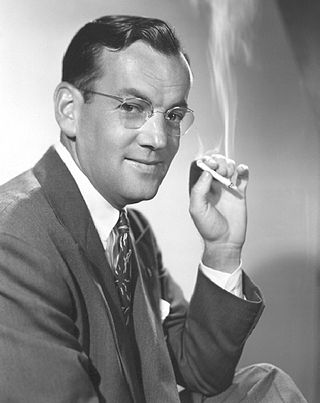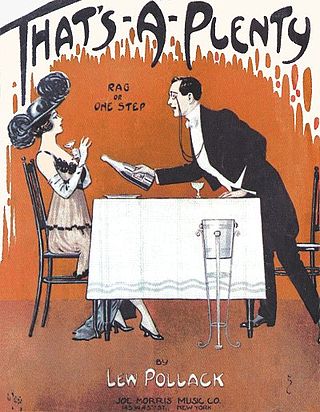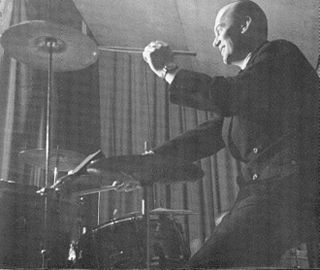This article needs additional citations for verification .(December 2009) |

"Little Brown Jug" is a song written in 1869 by Joseph Eastburn Winner, originally published in Philadelphia with the author listed as Winner's middle name "Eastburn".
This article needs additional citations for verification .(December 2009) |

"Little Brown Jug" is a song written in 1869 by Joseph Eastburn Winner, originally published in Philadelphia with the author listed as Winner's middle name "Eastburn".
It was originally a drinking song. It remained well known as a folk song into the early 20th century. Like many songs which make reference to alcohol, it enjoyed new popularity during the Prohibition era.


In 1939, Glenn Miller and His Orchestra released a hit version of the song on RCA Bluebird, as an A side 78 single, B-10286-A, in a new arrangement by Bill Finegan backed with "Pavanne". The recording was an early chart hit for Glenn Miller. The song was performed in Glenn Miller's Carnegie Hall concert that year and became a staple of the Glenn Miller Orchestra repertoire, and a classic of the Big Band era.
The personnel on the Glenn Miller recording: Saxes: Hal McIntyre, Tex Beneke, Wilbur Schwartz, Stanley Aronson, Al Klink; Trumpets: Bob Price, R. D. McMickle, Legh Knowles; Trombones: Glenn Miller, Paul Tanner, Al Mastren; Piano: Chummy MacGregor; String Bass: Rowland Bundock; Guitar: Allen Reuss; Drums: Moe Purtill.
The song was featured in and was central to the plot of the 1954 Universal Pictures film biography The Glenn Miller Story starring James Stewart and June Allyson. The Universal International Orchestra under the direction of Joseph Gershenson released a recording of the song from The Glenn Miller Story soundtrack as a single backed with "A String of Pearls" on Decca Records in the U.S. and on Brunswick Records in the UK in 1954.
Subsequently, in 1947 it was recorded by the accordionist John Serry Sr. and the guitarist Tony Mottola with the noted Joe Biviano Accordion & Rhythm Sextette for Sonora records. [1]
It was also sung by Carl "Alfalfa" Switzer and Harold "Slim" Switzer in an Our Gang (Little Rascals) short.
The song's lyrics are about a man and his wife and their hard life due to alcoholism. The tone and tune, however, are bright and cheerful, indicating the irony of the singer not knowing his degraded condition. The first verse of the song is:
My wife and I live all alone,
In a little log hut, we called our own
She loved gin, and I loved rum
I tell you what we'd lots of fun. [2]
In the 1948 Famous Studios Screen Song animated short titled "Little Brown Jug", a "bouncing ball" cartoon, it is sung with the music credited to Winston Sharples and entirely new lyrics by Buddy Kaye.
The song has been recorded by the following performers in addition to those listed above:
| External audio | |
|---|---|
Here on Archive.org |

A big band or jazz orchestra is a type of musical ensemble of jazz music that usually consists of ten or more musicians with four sections: saxophones, trumpets, trombones, and a rhythm section. Big bands originated during the early 1910s and dominated jazz in the early 1940s when swing was most popular. The term "big band" is also used to describe a genre of music, although this was not the only style of music played by big bands.

"Swing Low, Sweet Chariot" is an African-American spiritual song and one of the best-known Christian hymns. Originating in early oral and musical African-American traditions, the date it was composed is unknown. Performances by the Hampton Singers and the Fisk Jubilee Singers brought the song to the attention of wider audiences in the late 19th century. J. B. T. Marsh includes an early version of text and tune in his 1876 publication The Story of the Jubilee Singers, with Their Songs. The earliest known recording of "Swing Low, Sweet Chariot" was recorded in 1894, by the Standard Quartette.

"Beer Barrel Polka", originally in Czech "Škoda lásky", also known as "The Barrel Polka", "Roll Out the Barrel", or "Rosamunde", is a 1927 polka composed by Czech musician Jaromír Vejvoda. Lyrics were added in 1934, subsequently gaining worldwide popularity during World War II as a drinking song.

"Singin' in the Rain" is a song with lyrics by Arthur Freed and music by Nacio Herb Brown. Doris Eaton Travis introduced the song on Broadway in The Hollywood Music Box Revue in 1929. It was then widely popularized by Cliff Edwards and the Brox Sisters in The Hollywood Revue of 1929. Many contemporary artists have since recorded the song.

John Serry Sr. was an American concert accordionist, arranger, composer, organist, and educator. He performed on the CBS Radio and Television networks and contributed to Voice of America's cultural diplomacy initiatives during the Golden Age of Radio. He also concertized on the accordion as a member of several orchestras and jazz ensembles for nearly forty years between the 1930s and 1960s.

Alexander Emil Caiola was an American guitarist, composer and arranger, who spanned a variety of music genres including jazz, country, rock, and pop. He recorded over fifty albums and worked with some of the biggest names in music during the 20th century, including Elvis Presley, Ray Conniff, Ferrante & Teicher, Frank Sinatra, Percy Faith, Buddy Holly, Mitch Miller, and Tony Bennett.

RCA Thesaurus, a brand owned by RCA Victor, was a supplier of electrical transcriptions. It enjoyed a long history of producing electrical transcriptions of music for radio broadcasting which dated back to NBC's Radio Recording Division.
Anthony C. "Tony" Mottola was an American jazz guitarist who released dozens of solo albums. Mottola was born in Kearny, New Jersey and died in Denville.

"Chicago" is a popular song written by Fred Fisher and published in 1922. The original sheet music variously spelled the title "Todd'ling" or "Toddling." The song has been recorded by many artists, but the best-known versions are by Frank Sinatra, Ben Selvin and Judy Garland. The song alludes to the city's colorful past, feigning "... the surprise of my life / I saw a man dancing with his own wife", mentioning evangelist Billy Sunday as having not been able to "shut down" the city, and State Street where "they do things they don't do on Broadway".

"Nobody's Sweetheart", also known as "Nobody's Sweetheart Now" and "You're Nobody's Sweetheart Now", is a popular song, written in 1924, with music by Billy Meyers and Elmer Schoebel, and lyrics by Gus Kahn and Ernie Erdman. The song is a jazz and pop standard.

"Oh, You Beautiful Doll" is a ragtime love song published in 1911 with words by Seymour Brown and music by Nat D. Ayer. The song was one of the first with a twelve-bar opening.

"Somebody Stole My Gal" is a popular song from 1918, written by Leo Wood. In 1924, Ted Weems & his Orchestra had a five-week run at number one with his million-selling version. Its Pee Wee Hunt and his orchestra version is also known in Japan, particularly in Osaka and surrounding area as the theme song used by Yoshimoto Kogyo for their theatre comedies at Namba Grand Kagetsu and other venues.

Between 1938 and 1944, Glenn Miller and His Orchestra released 266 singles on the monaural ten-inch shellac 78 rpm format. Their studio output comprised a variety of musical styles inside of the Swing genre, including ballads, band chants, dance instrumentals, novelty tracks, songs adapted from motion pictures, and, as the Second World War approached, patriotic music.

"That's a Plenty" is a 1914 ragtime piano composition by Lew Pollack. Lyrics by Ray Gilbert were added decades later. Several popular vocal versions have been recorded, but it is more often performed as an instrumental.

This is a timeline documenting events of jazz in the year 1945.

This is a timeline documenting events of Jazz in the year 1947.

In the early 1940s in jazz, bebop emerged, led by Charlie Parker, Dizzy Gillespie, Thelonious Monk and others. It helped to shift jazz from danceable popular music towards a more challenging "musician's music." Differing greatly from swing, early bebop divorced itself from dance music, establishing itself more as an art form but lessening its potential popular and commercial value. Since bebop was meant to be listened to, not danced to, it used faster tempos. Beboppers introduced new forms of chromaticism and dissonance into jazz; the dissonant tritone interval became the "most important interval of bebop" and players engaged in a more abstracted form of chord-based improvisation which used "passing" chords, substitute chords, and altered chords. The style of drumming shifted as well to a more elusive and explosive style, in which the ride cymbal was used to keep time, while the snare and bass drum were used for accents. This appealed to a more specialized audiences than earlier forms of jazz, with sophisticated harmonies, fast tempos and often virtuoso musicianship. Bebop musicians often used 1930s standards, especially those from Broadway musicals, as part of their repertoire. Among standards written by bebop musicians are Gillespie's "Salt Peanuts" (1941) and "A Night in Tunisia" (1942), Parker's "Anthropology" (1946), "Yardbird Suite" (1946) and "Scrapple from the Apple" (1947), and Monk's "'Round Midnight" (1944), which is currently the most recorded jazz standard composed by a jazz musician. An early 1940s style known as "jumping the blues" or jump blues used small combos, uptempo music, and blues chord progressions. Jump blues drew on boogie-woogie from the 1930s. Kansas City Jazz in the 1930s as exemplified by tenor saxophonist Lester Young marked the transition from big bands to the bebop influence of the 1940s. These divergences from the jazz mainstream of the time initially met with a divided, sometimes hostile response among fans and fellow musicians, especially established swing players, who bristled at the new harmonic sounds. To hostile critics, bebop seemed to be filled with "racing, nervous phrases". Despite the initial friction, by the 1950s bebop had become an accepted part of the jazz vocabulary. The most influential bebop musicians included saxophonist Charlie Parker, pianists Bud Powell and Thelonious Monk, trumpeters Dizzy Gillespie and Clifford Brown, and drummer Max Roach.

The Glenn Miller Story is a 1954 soundtrack album released on Decca Records with songs from The Glenn Miller Story, the film biography of Glenn Miller, starring James Stewart and June Allyson. The collection had eight songs from the film recorded under the direction of Joseph Gershenson.
Thomas Henry Delaney was an American blues and jazz songwriter, pianist and singer, who wrote a number of popular songs, mainly in the 1920s. His work was recorded by many of the more fashionable singers and musicians of the period and later times, including Lillyn Brown, Lucille Hegamin, Original Dixieland Jass Band, Ethel Waters, Earl Hines, Count Basie, Bix Beiderbecke, Big Joe Williams, Clara Smith, Alberta Hunter, Clarence Williams, James P. Johnson, Woody Herman, Bukka White, Toots Thielemans, and Dinah Washington.
"La Cinquantaine" is a piece of music which was composed by Jean Gabriel-Marie in 1887.